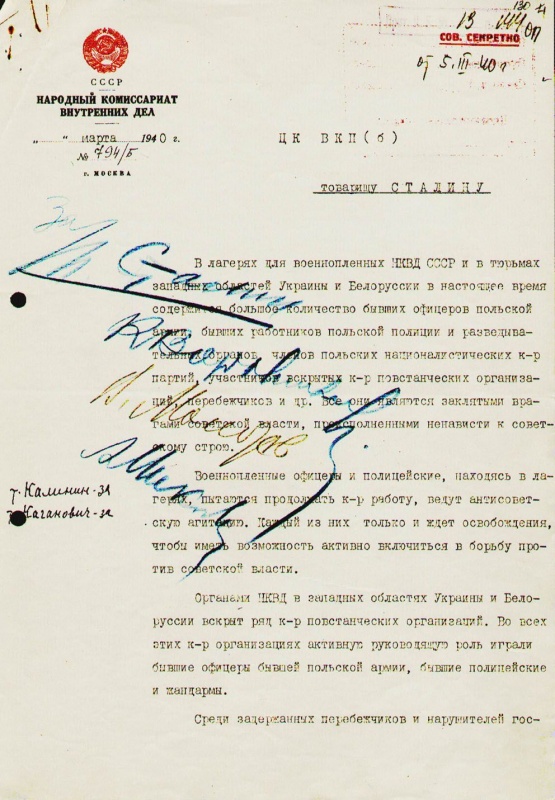
On 5 March 2020, it will be 80 years since the pivotal Session of the Politburo of the Central Committee of the All-Union Communist Party (Bolsheviks) – the highest authority in the Soviet Union. During that session, a decision was made to murder thousands of Poles – 14,700 officers and 11,000 civilians – who in 1940 found themselves in Soviet captivity. The mass murder, which took place in April and May 1940, is today remembered as the Katyn Massacre.
On 23 August 1939, the Third Reich and the Soviet Union signed the German-Soviet Treaty of Nonaggression (also known as the Molotov-Ribbentrop Pact or the Hitler-Stalin Pact), whose secret protocol provided for the division of Eastern Europe into German and Soviet spheres of influence. Putting this pact into action, Germany invaded Poland on 1 September 1939, with the Soviet aggression taking place on 17 September that same year. This annexation of Polish lands came to be known as the Fourth Partition of Poland.
About 250,000 prisoners, including 18,000 officers, were taken prisoner by the Soviet Union. A large number of those imprisoned were reserve officers, who back at home were members of the intelligentsia and worked as doctors, lawyers, engineers, teachers, government officials or landowners. Among these officers were also representatives of military clergy of various religious denominations: such as Catholicism, Orthodox, Judaism and Protestantism. In breach of international conventions, the officers were handed over to the NKVD – the Soviet security apparatus, which placed them in a specially created system of NKVD camps for Polish prisoners of war, which was subordinate to the Main Administration for Affairs of Prisoners of War and Internees of the NKVD. These were: Kozelsk – southeast of Smolensk, Starobelsk – in eastern Ukraine, and
Ostashkov – in northern Russia.
Protocol 13 of the above-mentioned Session of the Politburo talks about applying the maximum punishment towards all the Poles held captive in NKVD camps and prisons (although they were not subject to Soviet law). Their only blame was that they were Polish. The note features four signatures: That of Stalin, Voroshilov, Molotov and Mikoyan, accompanied by notes added by the secretary: “Kalinin – for”, “Kaganovich – for”.
The NKVD executed the prisoners of war with a shot to the back of the head using a pistol. The bodies were then buried covertly in forests around Katyn, Mednoye, Kharkiv and Kyiv. The location where the victims from today’s Belarus are buried is unknown – most likely it is the forest known as Kuropaty, located on the northern edge of Minsk.
Historians are still deliberating the real motive behind this massacre. Among other things, Stalin’s personal revenge for the Soviet defeat in the war with Poland in 1920 is being considered. However, the most probable is the cooperation of the two terror apparatuses – the Soviet NKVD and the German Gestapo – which approved the massacre at several joint conferences held at the turn of 1939 and 1940 and carried them out in order to physically annihilate the Polish elite. Some sources exist which confirm the presence of German officers during the executions, acting as observers.
The world first heard about this crime on 11 April 1943, when the Transocean Agency – a German press agency – announced the discovery of the bodies of Polish officers by German soldiers in the Katyn forest. Two days later, this information was repeated by Radio Berlin. This was the beginning of falsifying and concealing the Katyn Massacre by the Soviets, which the historians refer to as the “Katyn Lie”. It was not until 13 April 1990 that the then general secretary of the Communist Party of the Soviet Union – Mikhail Gorbachev – conceded that the crime was committed by the NKVD. Nonetheless, many circumstances surrounding the Katyn Massacre remain unexplained, and Vladimir Putin’s Russia is doing everything to keep it that way.
On 30 November 2004, Poland’s Institute of National Remembrance issued a decision to launch an investigation into the Katyn Massacre. The justification of the decision stated that the mass murder, by shooting, of not less than 21,768 Polish citizens was the most serious crime against humanity defined as genocide, because the perpetrators’ motive, who issued the order of 5 March 1940, was the liquidation of Polish citizens because of their nationality.
Artur Kolęda
The author is a historian, columnist and employee of the Institute of National Remembrance.
